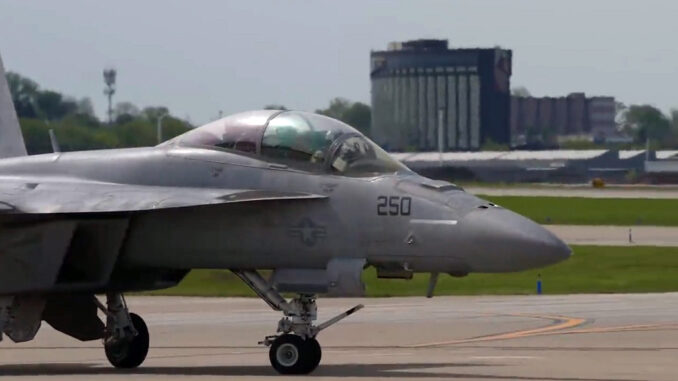Boeing Begins Block III Upgrades On U.S. Navyâs Super Hornets

The U.S. Navy delivered to Boeing the first Block II aircraft that will be upgraded to the new Block III configuration.
With a short video clip released on social media, Boeing announced the arrival at its St. Louis facilities of the first F/A-18 Block II Super Hornet that will be upgraded to the new Block III configuration. The Block III upgrades will be applied as part of the Service Life Modernization program, which will add 4,000 flight hours to the service life of the already delivered Super Hornets.
The F/A-18E and F/A-18F currently form the backbone of the Carrier Air Wings, being able to perform all air-to-air and air-to-ground mission profiles. The U.S. Navy took delivery of its final Block II Super Hornet, the last of 322 single-seat F/A-18E and 286 two-seat F/A-18F jets delivered since 2005, on April 17, 2020. On September 24, 2021, Boeing delivered to the Navy the first of 78 newly built Block III Super Hornets.
The first @USNavy Block II #SuperHornet to receive the Block III avionics kit has arrived in St. Louis for service life modification. The jet will depart with a 4,000 flight hour increase, a large area touch screen display and upgraded capabilities. pic.twitter.com/OkGczxEEVr
— Boeing Defense (@BoeingDefense) July 13, 2023
The first phase of the SLM program has already been in motion for some years, extending the service life of the Super Hornet from 6,000 to 7,500 flight hours. The second phase, which is starting this year, is looking to extend the service life to 10,000 flight hours and perform the modifications required for the Block III upgrades.
The key capabilities made available by the new variant include Advanced Cockpit System centered around the 10×19 inch large-area touchscreen display, an advanced network infrastructure that incorporates the Distributed Targeting Processor Network (DTP-N) and the Tactical Targeting Network Technology (TTNT), open mission systems, reduced radar signature, a 10,000-hour airframe, the AN/ASG-34 IRST (Infrared Search-and-Track) and Conformal Fuel Tanks (CFT) with an additional 3500 lb fuel capacity.
Meanwhile, for comparison, the advanced cockpit station & large area display of the Boeing Block III Super Hornet – which flew earlier this year. #avgeek #TacFighterTues pic.twitter.com/d5w8iXGl12
— Tim Robinson (@RAeSTimR) May 14, 2019
There are currently three work lines involved in the program, two in St. Louis and one at the Fleet Readiness Center Southwest, which can modify up to 40 aircraft per year. Last year, Rear Adm. Andrew Loiselle, director of Air Warfare Division in the Office of the Chief of Naval Operations, mentioned that the implementation of best practices during Phase One SLM allowed a 30% percent cost reduction. The initial SLM budgeted cost per aircraft was $5.5 million, with a turnaround time of 15-17 months.
The first F/A-18 Super Hornet fighter aircraft to undergo the Service Life Modification (SLM) procedure at a naval aviation depot is pictured at the FRCSW testline June 29. The aircraft, assigned to Strike Fighter Squadron (VFA) 106, will undergo induction for the SLM that will extend the airframe’s flight hours from 6,000 to 7,500. The procedure is estimated to take about 17 months. (U.S. Navy photo)
” data-medium-file=”https://theaviationist.com/wp-content/uploads/2023/07/First_Super_Hornet_BlockIII_Upgrade_2-460×306.jpg” data-large-file=”https://theaviationist.com/wp-content/uploads/2023/07/First_Super_Hornet_BlockIII_Upgrade_2-706×470.jpg” decoding=”async” class=”size-large wp-image-82945″ src=”https://theaviationist.com/wp-content/uploads/2023/07/First_Super_Hornet_BlockIII_Upgrade_2-706×470.jpg” alt width=”706″ height=”470″ srcset=”https://theaviationist.com/wp-content/uploads/2023/07/First_Super_Hornet_BlockIII_Upgrade_2-706×470.jpg 706w, https://theaviationist.com/wp-content/uploads/2023/07/First_Super_Hornet_BlockIII_Upgrade_2-460×306.jpg 460w, https://theaviationist.com/wp-content/uploads/2023/07/First_Super_Hornet_BlockIII_Upgrade_2-128×85.jpg 128w, https://theaviationist.com/wp-content/uploads/2023/07/First_Super_Hornet_BlockIII_Upgrade_2-768×512.jpg 768w, https://theaviationist.com/wp-content/uploads/2023/07/First_Super_Hornet_BlockIII_Upgrade_2.jpg 1024w” sizes=”(max-width: 706px) 100vw, 706px”>
“We expect continued cost savings as SLM matures and we are executing our planned transition to full-kit, 10,000-hour SLM inductions if fiscal ’23,” said Rear Adm. Loiselle. “Full-kit inductions will provide full Block III capability identical to new production aircraft at one third of the cost, giving us 4,000 additional flying hours, or enough to fly for 13 additional years.”
The number of aircraft that will be upgraded and see their service life extended is not yet clear, as the Navy has not yet finalized it. The SLM however will be used to control the availability of the aircraft, eventually ramping up or scaling down the program according to future budgets, schedules and requirements.
“Right now, I do not plan to do SLM on the entirety of my Block II force and I do not plan to do it on my Block I force,” said last year Rear Adm. Loiselle. “If there are changes in the future that require additional capabilities [and] I need more Block III aircraft, then I have the ability to dial up that rheostat on SLM and be able to do that for a longer period of time and to potentially use the FRCs [Fleet Readiness Centers] to increase capacity for SLM beyond the currently planned 35 per year.”
